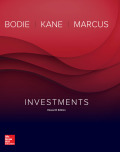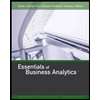
A
To think critically about: Bond portfolio at the starting of the year then calculates the return. Compare the return with the return actully obtained.
Introduction: Comparison of return from resulting value with actual return will not differ. Checking the bond value throughout the year will gives same returns.
B
To think critically about: Average weighted returns of the portfolio by using long bond market index and T-bills. Return should be compared with the annual return.
Introduction: Actual weights are used to calculate the average returns of a portfolio. Market index and T-bills tools are used in this approach.
C
To think critically about: For every quarter of the year, the net bond purchase activity will be examined.
Introduction: For every quarter of the year, bond purchasing activity is examined until its value becomes negative. The sign of the purchase will be taken by the manager.
Want to see the full answer?
Check out a sample textbook solution
Chapter 24 Solutions
EBK INVESTMENTS
- What is the future value of $500 invested for 3 years at an annual compound interest rate of 4%?arrow_forwardA loan of $10,000 is taken at an annual interest rate of 6% for 5 years. What is the total interest payable under simple interest? Expalarrow_forwardA loan of $10,000 is taken at an annual interest rate of 6% for 5 years. What is the total interest payable under simple interest?arrow_forward
- You borrow $8,000 at an annual interest rate of 7%, and it compounds yearly for 2 years. What is the total amount payable? Helparrow_forwardYou borrow $8,000 at an annual interest rate of 7%, and it compounds yearly for 2 years. What is the total amount payable?arrow_forwardIf a bond pays $50 annually and is priced at $1,000, what is its annual yield? Explarrow_forward
- If a bond pays $50 annually and is priced at $1,000, what is its annual yield?arrow_forwardA car loan of $15,000 is taken for 3 years at an annual interest rate of 8%. What is the simple interest payable?arrow_forwardYou gave me unhelpful so i am also gave you unhelpful.if you will not give unhelpful then also i will not give unhelpful. what is finance?arrow_forward
- You want to save $15,000 in 5 years. If your bank offers 3% annual interest, how much should you invest today? (Use compound interest.) Explarrow_forwardIf you invest $2,000 at an annual interest rate of 6%, compounded annually, for 3 years, what is the future value?arrow_forwardYou want to save $15,000 in 5 years. If your bank offers 3% annual interest, how much should you invest today? (Use compound interest.)arrow_forward
 Essentials of Business Analytics (MindTap Course ...StatisticsISBN:9781305627734Author:Jeffrey D. Camm, James J. Cochran, Michael J. Fry, Jeffrey W. Ohlmann, David R. AndersonPublisher:Cengage Learning
Essentials of Business Analytics (MindTap Course ...StatisticsISBN:9781305627734Author:Jeffrey D. Camm, James J. Cochran, Michael J. Fry, Jeffrey W. Ohlmann, David R. AndersonPublisher:Cengage Learning
